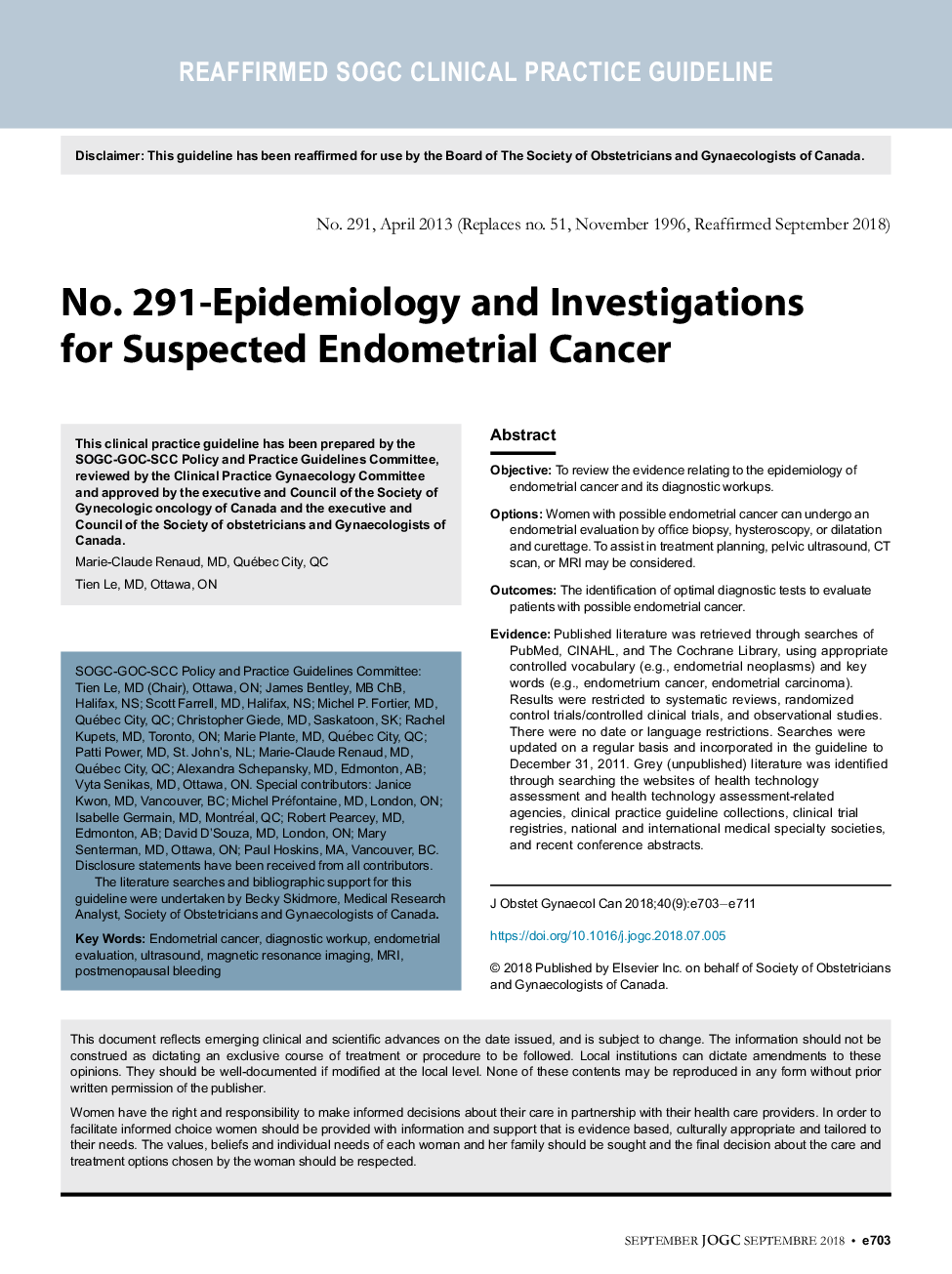| کد مقاله | کد نشریه | سال انتشار | مقاله انگلیسی | نسخه تمام متن |
|---|---|---|---|---|
| 11022007 | 1701768 | 2018 | 9 صفحه PDF | دانلود رایگان |
عنوان انگلیسی مقاله ISI
No. 291-Epidemiology and Investigations forSuspected Endometrial Cancer
ترجمه فارسی عنوان
شماره 291 - اپیدمیولوژی و تحقیقات برای سرطان آندومتر مورد انتظار
دانلود مقاله + سفارش ترجمه
دانلود مقاله ISI انگلیسی
رایگان برای ایرانیان
کلمات کلیدی
موضوعات مرتبط
علوم پزشکی و سلامت
پزشکی و دندانپزشکی
زنان، زایمان و بهداشت زنان
چکیده انگلیسی
ObjectiveTo review the evidence relating to the epidemiology of endometrial cancer and its diagnostic workups.OptionsWomen with possible endometrial cancer can undergo an endometrial evaluation by office biopsy, hysteroscopy, or dilatation and curettage. To assist in treatment planning, pelvic ultrasound, CT scan, or MRI may be considered.OutcomesThe identification of optimal diagnostic tests to evaluate patients with possible endometrial cancer.EvidencePublished literature was retrieved through searches of PubMed, CINAHL, and The Cochrane Library, using appropriate controlled vocabulary (e.g., endometrial neoplasms) and key words (e.g., endometrium cancer, endometrial carcinoma). Results were restricted to systematic reviews, randomized control trials/controlled clinical trials, and observational studies. There were no date or language restrictions. Searches were updated on a regular basis and incorporated in the guideline to December 31, 2011. Grey (unpublished) literature was identified through searching the websites of health technology assessment and health technology assessment-related agencies, clinical practice guideline collections, clinical trial registries, national and international medical specialty societies, and recent conference abstracts.ValuesThe quality of evidence was rated using the criteria described in the Report of the Canadian Task Force on Preventive Health Care (Table 1).Benefits, harms, and costsThis document is intended to guide the development of a standardized cost-effective investigation of patients with suspected endometrial cancer.ValidationThe guideline was reviewed for accuracy by experts in pathology, radiation oncology, and medical oncology. Guideline content was also compared with relevant documents from the American Congress of Obstetricians and Gynecologists.RECOMMENDATIONS1A complete focused history should be taken and a physical examination carried out in patients with suspected endometrial cancer. Attention should be paid to predisposing factors for excess estrogen stimulation of the endometrium such as long history of anovulation, obesity, menstrual irregularity, or long-term use of unopposed estrogen or tamoxifen. Patients with a strong family history of endometrial, ovarian, and colorectal cancers might have inherited Lynch syndrome (hereditary non-polyposis colorectal cancer syndrome) that increases their lifetime risk of developing endometrial cancer. Genetic counselling and testing can be used to individualize risk-management interventions including screening strategies and treatment options (III-B).2Endometrial cancer should be ruled out in perimenopausal and postmenopausal patients with abnormal vaginal bleeding (II-1A).3Depending on access, histologic endometrial evaluation and transvaginal ultrasound are the preferred initial diagnostic investigations for patients with suspected endometrial cancer (II-1B).4Histologic evaluation of the endometrium should be done in all patients in whom endometrial cancer is suspected (II-1A).5Hysteroscopic examination should be considered in patients with persistent uterine bleeding with benign endometrial sampling or insufficient endometrial sampling after ultrasound (II-2B).6Formal review of the histopathology should be considered in patients with high grade tumours or rare histologic types such as serous, clear cell, or mucinous types (III-B).7Additional tumour markers, CT scan, and MRI scan should not be used routinely (III-D).
ناشر
Database: Elsevier - ScienceDirect (ساینس دایرکت)
Journal: Journal of Obstetrics and Gynaecology Canada - Volume 40, Issue 9, September 2018, Pages e703-e711
Journal: Journal of Obstetrics and Gynaecology Canada - Volume 40, Issue 9, September 2018, Pages e703-e711
نویسندگان
Marie-Claude MD, Tien MD,
